Yinka Shonibare CBE @ The Serpentine Gallery
12th Apr – 1st Sep 2024
Suspended States
Shonibare CBE is an intriguing artist. Part of the YBA group that emerged from Goldsmiths in the early 1990s, his practice is less conceptual than that of most of his contemporaries. His work explores and interrogates the entangled relationship between colonialism and cultural identity and the people whose lives that affects. The use of Dutch wax printed cotton in many of his works highlights the intertwined histories of the coloniser and the colonised.
This small exhibition at the Serpentine, is both powerful and flawed. Powerful because it puts a spotlight on our colonial past and flawed because it opts to provide factual information rather than risk offering criticism. This is perhaps not surprising. In a recent interview, Shonibare criticised the toppling of the Colston statue into the Bristol harbour by saying that we shouldn’t be erasing history and likening the act to book burning. Lauded by establishment voices as a ‘nuanced view’ this, in itself, should be setting off alarm bells for Shonibare, but doesn’t appear to be.
That aside, if you’re not that familiar with his work, then this exhibition does provide a good snapshot of his practice and provides plenty of information for further research. Below are some of the key works.
‘The War Library’ (2024)
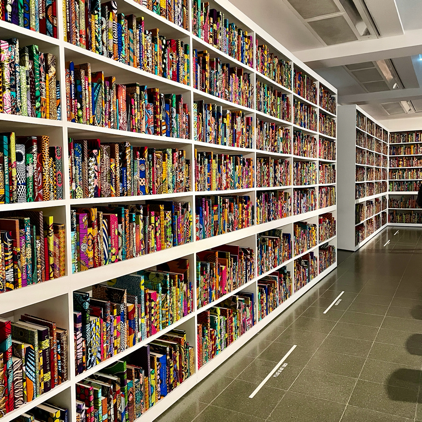
‘The War Library’ (2024)
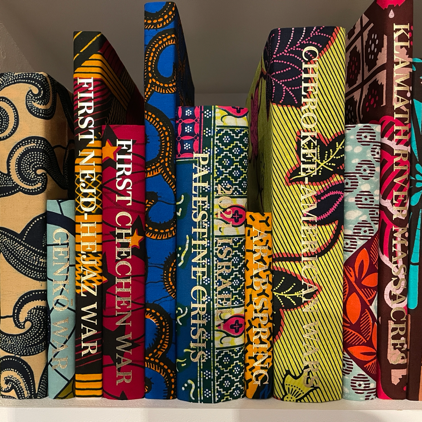
‘The War Library’ (2024) - Detail
Undoubtedly the highlight and most moving part of the exhibition. 5270 books covered in Dutch wax cotton fabric, 2700 of which have gold lettering on the spine highlighting a past war or peace treaty. A monumental work, that if you come across unexpectedly, as I did, does take your breath away. The sheer amount of suffering and bloodshed bound in those volumes is quite distressing. The unlabelled volumes depressingly referring to those wars and treaties yet to come. The installation itself is however simply a front for the real work and research that produced it. Accompanying computer databases can be accessed giving brief descriptions of each of the wars and treaties included. A lot of research went into this installation.
However, on chatting with the gallery assistant, it transpires that the books aren’t genuine texts, simply random books covered in fabric and given a relevant title. Did their arrangement on the shelves have any significance/order? Apparently not; the order is random and the only criteria for their placement on the shelves was that no two books of the same height should be next to each other. The aesthetic created therefore deemed more important than the content.
‘Decolonised Structures’ (2022)
Seven statues, more commonly seen atop large plinths and gracing important squares, are presented here at ground level and coloured in prints reminiscent of the Dutch wax cloth cotton introduced by the Dutch from Indonesia, a reminder of the interwoven histories of land, culture, trade and empires. Each statue, a key figure in British colonial history.
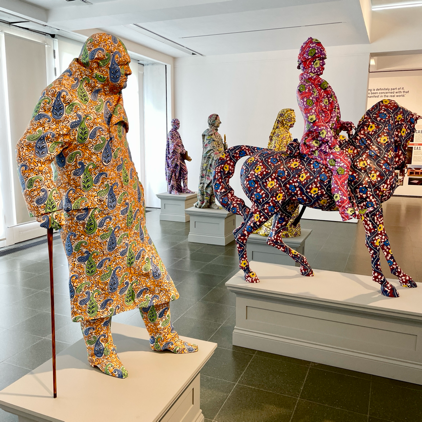
‘Decolonised Structures’ (2022)
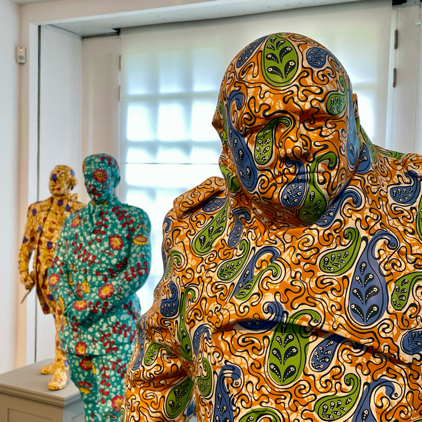
‘Decolonised Structures’ (2022) - Detail
Winston Churchill, a leader central to Britain’s war image, but also a man with overtly ethnocentric and racist views, believing in the superiority of the European race over those of the indigenous cultures in North America and Africa. Views which some argue contributed to the death of three millon Indians in the Bengal famine of 1943.
Frederick Roberts, a man who was in command during the second Anglo-Boer war in Southern Africa. A war which saw enemy survivors interned in concentration camps. An estimated 48000 died in British run concentration camps.
Queen Victoria, whose reign oversaw an exponential growth in the British empire and the plunder that that entailed.
The other statues are those of Charles Napier, Henry Frere, Robert Clive and Herbert Kitchener. However, beautiful as they are, does covering replicas of famous statues in wax cotton motifs constitute an attempt at decolononisation? I would argue not and once again it shows Shonibare holding back; perhaps not wishing to bite the hand that feeds him.
‘Sanctuary City’ (2024)
A darkened room. Models of buildings constructed from wood and painted black, their form melting into the darkness; except that each building is lit from the inside and the light provides a comforting and welcoming glow. That is the intention as each of the buildings in this ‘city’ have historically been used as a sanctuary, a place of refuge.
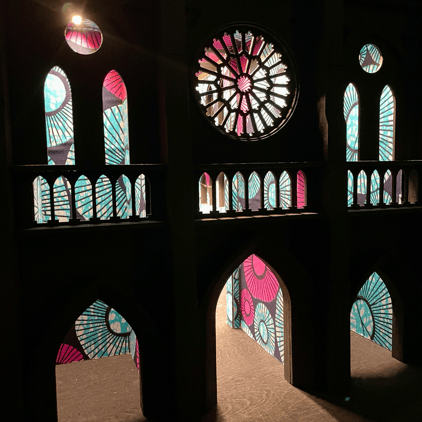
‘Sanctuary City - Notre Dame’ (2024)
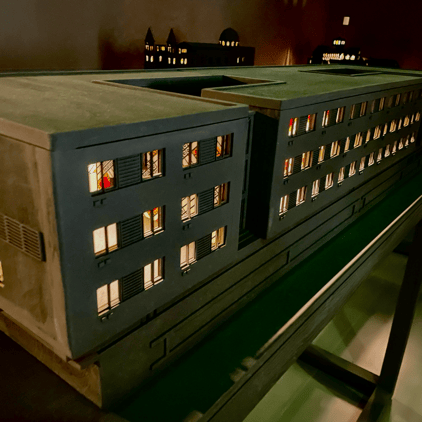
‘Sanctuary City - Bibby Stockholm’ (2024)
Shonibare here casts his net wider and is starting to look at displaced people in general and the places that have offered them shelter and refuge. Notre-Dame, which as with other churces in Medieval times provided a sanctuary for those fleeing persecution. The United Nations HQ building in New York, whose principal aim is to facilitate dialogue and promote friendship between nations, as well as The Amnesty International building in London to name but a few.
An odd inclusion here however is the Bibby Stockholm barge in Dorset used to house asylum seekers. Its intentionally poor living conditions and its role in the UK Government’s anti-immigration drive would I think place it in the category of detention facility or centre of incarceration rather than a place of refuge. In this respect Issam Kourbaj’s depiction of the same subject is more accurate.
Shonibare’s aim is to tackle the contentious and complex legacies of our colonial past. He certainly presents beuatiful work, but does it challenge the Establishment and power? I’m not convinced that any person or institution that has profited from colonial rule will be troubled by these works and one questions why Shonibare has taken this route. Having been awarded the CBE in 2019, Shonibare added it to his name, allegedly to highlight the ambiguities and contradictions associated with the title. A rebel working from inside the establishment? However, this smacks of window dressing. A stronger message would have been to publicaly decline the award and then have CBE proudly printed after your name.
The lure of being on the inside has proved too hard to resist for Shonibare.